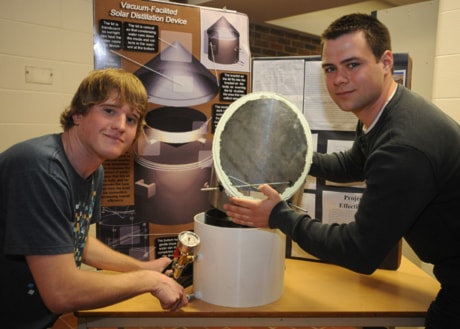Scientific ingenuity is alive and well at Red Deer College.
Three teams of students recently matched intellect and creativity in a design competition organized by the RDC Student Science and Engineering Society. What resulted was a process for accelerating the composting of organic material, the means with which to expand the video capabilities of a laptop computer, and a way to harness the sun to desalinate and purify water.
The third invention — developed by Connor Shannon, Conor Mcleod, Bryson Peeters and Ryan Carlyle — earned the top mark from a panel of judges that included former Red Deer College science instructors and a University of Calgary engineering professor. They were sufficiently impressed with the quality of the other entries that they awarded each second-place standing, said Warren Elgersma, chair of the RDC science department.
Shannon, Mcleod, Peeters and Carlyle’s creation consisted of a sealed container in which evaporating water collected on sloped lid and drained into a catch basin below. The young inventors even tried to create a vacuum within their device to improve its efficiency.
“It was different,” said Peeters of the non-classroom exercise. “I had a lot of fun with it.”
Shannon agreed that it was refreshing to apply their knowledge to a practical project. Both he and Peeters were in the first year of the engineering program at Red Deer College.
“Second year, it seems they start throwing things like this at you more often.”
“It’s really great to have an idea at the beginning of the semester that turns into a real prototype by the time the competition is over,” added Shannon.
The winning foursome was even able to utilize the resources of the college’s Applied Research and Innovation Department, such as a rapid-prototyping machine.
In the case of the composting project, the students modified a rain barrel — with a mesh platform, access doors and a drain — to create ideal conditions for decomposition.
“That way, you could put your compost in the middle and the compost would stay moist and actually decompose a lot faster,” said Elgersma.
The accessory for the laptop web camera consisted of a periscope-like device that fit over the camera so that it could capture an image in front of the computer.
“That way, when they’re taking notes they could also video the lecture,” explained Elgersma.
The RDC Student Design Competition was open to science and engineering students at the college, with each team required to have at least one science and one engineering student.
Nova Chemicals provided $2,000 in awards for the event.
The competition began in January, with judging taking place the beginning of this month. Viability, marketability and problem-solving potential were among the criteria the judges considered.
Elgersma, who oversaw the competition with other faculty members, said he hopes the competition will be repeated next year.
hrichards@www.reddeeradvocate.com
